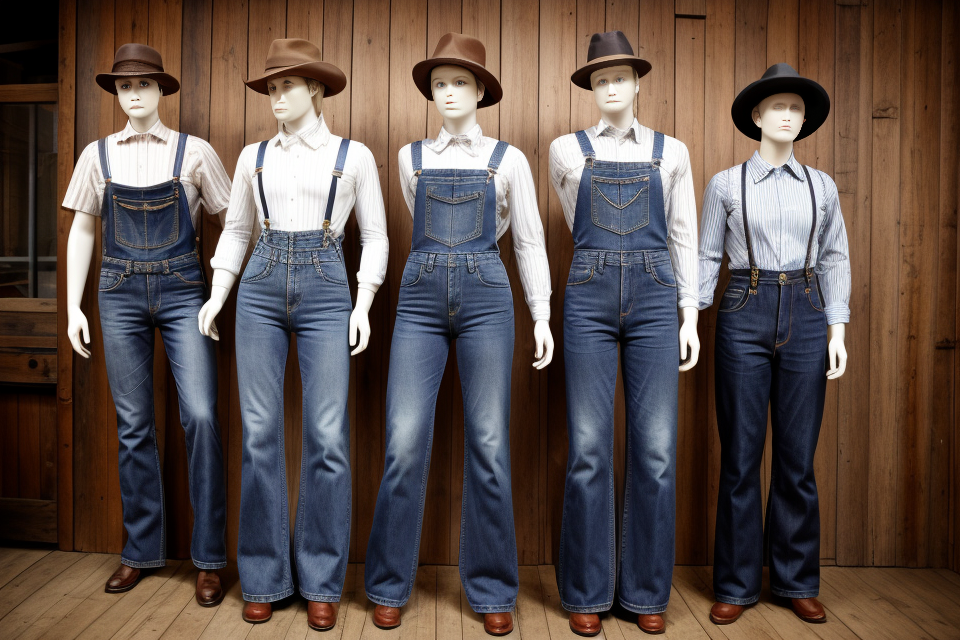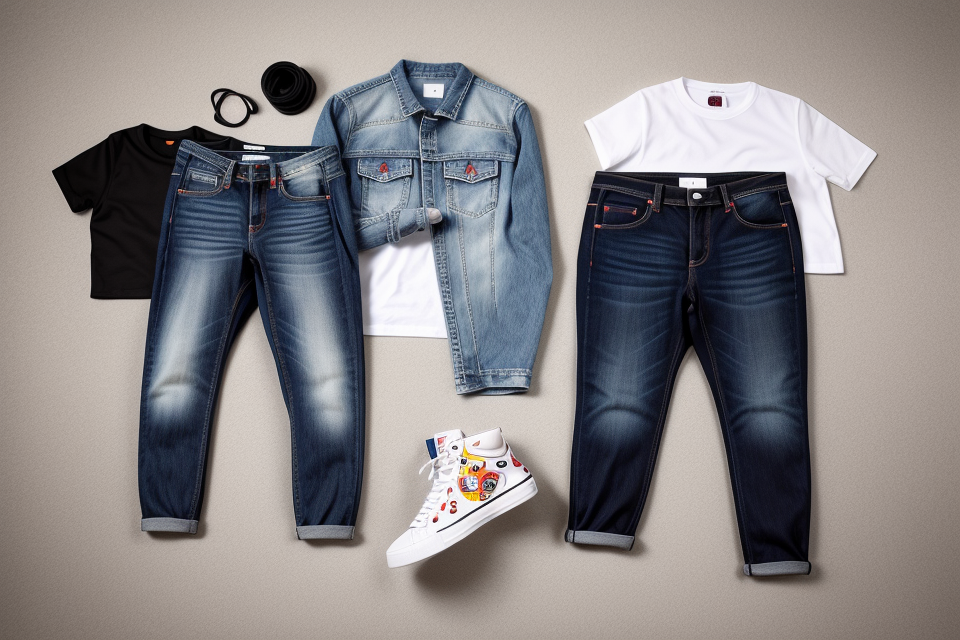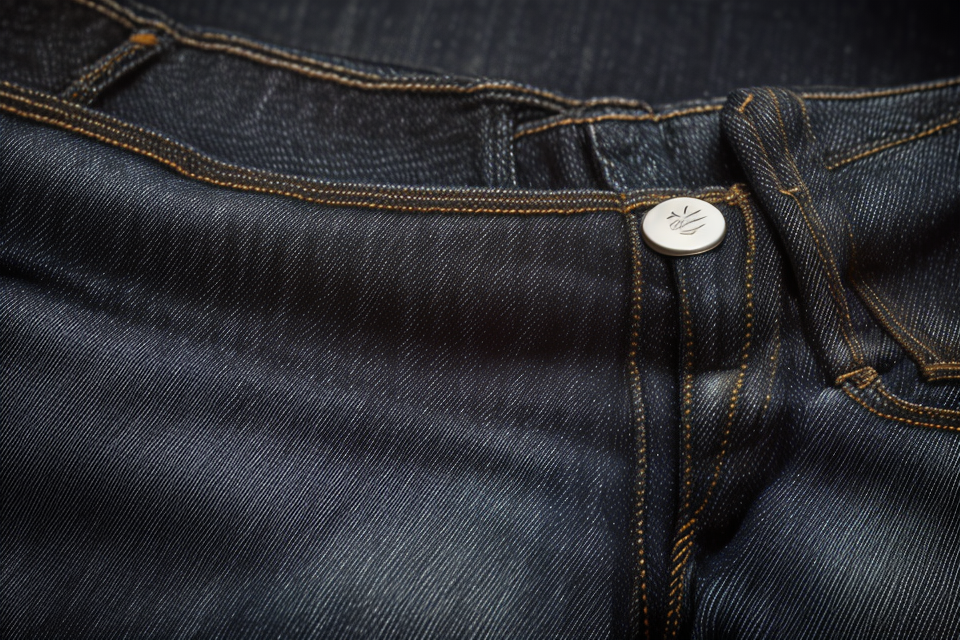Denim has been a staple in the world of fashion for centuries, and jeans have become a wardrobe essential for millions of people around the world. But have you ever wondered which brand of jeans has been around the longest? In this article, we will delve into the history of denim fashion and explore the oldest brand of jeans that has stood the test of time. From its humble beginnings to its evolution into a global fashion icon, we will uncover the rich history of this iconic garment and the brand that started it all. So, buckle up and get ready to discover the fascinating story behind the oldest brand of jeans.
The oldest brand of jeans is likely Levi’s, which was founded in 1853 in San Francisco, California. Levi’s was initially a dry goods store, but it quickly began producing denim overalls and other workwear for the growing population of miners and laborers in the area. The brand became popular due to its durability and quality, and it quickly gained a reputation as a trusted and reliable source of denim clothing. Over the years, Levi’s has continued to evolve and innovate, and it remains one of the most iconic and beloved denim brands in the world today. Other early denim brands include Wrangler, which was founded in 1947, and Lee, which was founded in 1889. These brands, along with Levi’s, helped to establish denim as a popular and enduring fashion trend.
The origin of jeans
The fabric that became a symbol
Denim has been a staple fabric for many years, but it wasn’t always the symbol of fashion that it is today. The fabric originated in Nimes, France, where it was originally used to make uniforms for sailors and soldiers. It was later adopted by American cowboys, who wore it as a durable and practical material for their work.
The popularity of denim really took off in the 1950s, when Hollywood and rock and roll played a significant role in its evolution. Jeans were no longer just a practical workwear item, but a fashion statement that became a symbol of rebellion and individuality.
As the popularity of jeans continued to grow, so did the styles and variations of the fabric. Designers began experimenting with different cuts, washes, and finishes, leading to the wide range of styles that we see today.
Despite its origins as a practical workwear fabric, denim has become a symbol of fashion and individuality that is beloved by people all over the world. Its versatility and durability have made it a staple in wardrobes for decades, and its timeless appeal shows no signs of fading.
The oldest brands of jeans
Levi’s
The story of Levi’s Strauss and Jacob Davis
In 1853, Levi Strauss, a Jewish immigrant from Germany, and Jacob Davis, a tailor from Latvia, began a partnership in San Francisco, California. Strauss was a dry goods merchant, and Davis was a customer who frequently made alterations to his pants. Together, they patented a process for riveting blue jeans, creating a durable and practical garment that would become an American icon.
The evolution of Levi’s jeans
Levi’s jeans have undergone several evolutions over the years, from their initial use as workwear for miners and ranchers to their current status as a fashion staple. In the early years, the jeans were made with a distinctive “XX” rivet on the waistband, indicating the patented process. Later, the company introduced the 501 Jean, a style that remains popular today.
The 501 Jean
The 501 Jean is Levi’s most famous style, and it has been produced continuously since 1890. The jean is characterized by its slim fit, watch pocket stitching, and two-horse logo on the back pocket. Over the years, the 501 Jean has been modified with different cuts, materials, and colors, but it remains an iconic symbol of American style.
The evolution of the 501 Jean
The 501 Jean has undergone several changes over the years, with each new iteration reflecting the changing tastes and styles of the time. In the 1960s, the jean was modified to include a zip fly, and in the 1990s, it was made in a variety of colors and styles to appeal to a younger market. Today, the 501 Jean is available in a range of fits, from slim to relaxed, and it continues to be a popular choice for both casual and fashion-conscious consumers.
The iconic status of Levi’s jeans
Levi’s jeans have become a symbol of American style and culture, and they are recognized and coveted around the world. The brand’s iconic status is due in part to its long history and in part to its innovative marketing efforts, which have included memorable advertising campaigns and high-profile collaborations with fashion designers.
The role of advertising in building the Levi’s brand
Levi’s has been a master of advertising, using catchy slogans and memorable imagery to create a strong brand identity. Over the years, the company has launched several successful campaigns, including the “Live in Levi’s” campaign of the 1980s and the “Invent Your Own Rules” campaign of the 2010s. These campaigns have helped to cement the brand’s reputation as a symbol of American cool.
The impact of Levi’s on the jeans industry
Levi’s has had a significant impact on the jeans industry, both in terms of its products and its marketing strategies. The company’s focus on quality and durability helped to establish denim as a practical and stylish fabric, and its innovative marketing efforts have inspired other brands to follow suit. Today, Levi’s remains one of the most iconic and influential denim brands in the world.
Wrangler
The story of Wrangler and the Blue Bell Manufacturing Company
Wrangler, founded in 1943, is one of the oldest denim brands in the world. It all began when the Blue Bell Manufacturing Company, a small textile mill located in North Carolina, started producing denim overalls for workers. The overalls quickly gained popularity, and in 1947, the company rebranded as Wrangler and began producing jeans.
The evolution of Wrangler jeans
Over the years, Wrangler has become a household name in the denim industry, known for its high-quality and durable jeans. In the 1960s, Wrangler introduced its iconic red and white script logo, which has since become synonymous with the brand.
The Wrangler brand and its focus on the Western market
Wrangler has always had a strong connection to the Western market, which has been reflected in its product design. The brand’s focus on the Western market has led to the creation of several iconic styles, such as the Wrangler Cowboy Cut and the Wrangler Arizona.
The impact of Wrangler on the jeans industry
Wrangler has had a significant impact on the jeans industry, particularly in the Western market. The brand’s focus on quality and durability has set the standard for other denim brands, and its innovative designs have inspired countless imitators.
The role of innovation in the success of Wrangler
Wrangler’s success can be attributed to its commitment to innovation. The brand has consistently pushed the boundaries of denim design, introducing new materials, styles, and technologies that have helped it stay ahead of the competition. For example, in the 1970s, Wrangler introduced its revolutionary “Rigid Flex” technology, which made jeans more durable and comfortable.
Today, Wrangler continues to be a leader in the denim industry, with a reputation for producing some of the highest-quality and most innovative jeans on the market.
Lee
The story of the Lee company and its founder, Henry David Lee
In 1889, Henry David Lee, a tailor from Latvia, founded the Lee company in Kansas, United States. He was inspired to create a new type of garment that would be practical, durable, and comfortable for the American people.
The evolution of Lee jeans
The first-ever Lee jean was a loose-fitting, straight-legged trouser made from denim. It was designed to be a sturdy work garment that could withstand the demands of manual labor. The jean was designed with a button-fly, which was a new innovation at the time.
The impact of Lee on the jeans industry
Lee’s jeans quickly gained popularity among working-class Americans, who appreciated their durability and practicality. The company’s marketing campaigns emphasized the jeans’ toughness and versatility, and they became a symbol of American ruggedness and individualism.
The rise and fall of the Lee brand
The Lee brand became a household name in the United States and eventually expanded internationally. However, in the 1990s, the company faced financial difficulties and was sold to a Korean conglomerate. Despite this setback, the Lee brand continues to be a popular and respected name in the world of denim fashion.
Other early jeans brands
Overall
The history of Overall and its founder, Robert E. Overall
Overall was founded by Robert E. Overall in 1882, making it one of the oldest jeans brands in the world. The company started as a small business, producing workwear for miners and other laborers in the Pacific Northwest region of the United States. Robert E. Overall was a Canadian immigrant who had experience in the clothing industry, and he saw an opportunity to provide durable and comfortable clothing for the growing number of workers in the area.
The evolution of Overall jeans
Overall jeans were initially designed as functional workwear, with features such as reinforced pockets and sturdy stitching to withstand the demands of manual labor. The early Overall jeans were made from heavy denim and had a loose, baggy fit that allowed for freedom of movement.
In the early years, Overall jeans were primarily sold to miners and lumberjacks, but as the brand gained popularity, it began to expand its customer base. In the 1920s, Overall introduced a slimmer cut for its jeans, which appealed to a wider range of customers.
The early years of Overall
During the 1930s and 1940s, Overall continued to grow, and the brand became known for its high-quality workwear. The company’s reputation was built on its commitment to durability and functionality, and its jeans were favored by workers in a variety of industries.
The rise of Overall during the 1950s
The 1950s were a boom period for Overall, as the company’s jeans became popular among teenagers and young adults. The brand’s marketing efforts during this time focused on promoting the jeans as a symbol of rebellion and individuality, and Overall jeans were worn by many of the era’s most famous musicians and actors.
The decline of Overall in the 1960s
In the 1960s, the popularity of Overall jeans began to decline, as younger consumers turned to more fashionable brands and styles. The company struggled to adapt to the changing fashion landscape, and by the end of the decade, it was no longer a major player in the jeans industry.
The impact of Overall on the jeans industry
Despite its eventual decline, Overall played a significant role in the development of the jeans industry. The brand’s early focus on durability and functionality helped establish the reputation of jeans as a practical and long-lasting form of clothing. Additionally, Overall’s marketing efforts during the 1950s helped to popularize jeans as a fashion statement, paving the way for the rise of other denim brands in the years that followed.
Strauss-Humphreys
The story of Strauss-Humphreys and its founder, Morris Goldfarb
In the early 1900s, Morris Goldfarb, a Jewish immigrant from Eastern Europe, arrived in the United States with a dream of starting his own business. After working for several years in the garment industry, he finally opened his own denim factory in 1919, which he named Strauss-Humphreys after his two sons.
The evolution of Strauss-Humphreys jeans
From its humble beginnings, Strauss-Humphreys quickly became known for producing high-quality denim that was both durable and stylish. In the 1920s, the company introduced its iconic “Big S” logo, which became synonymous with the brand’s reputation for quality and craftsmanship.
The early years of Strauss-Humphreys
During the 1930s and 1940s, Strauss-Humphreys continued to grow and expand its product line, introducing new styles and cuts of jeans that were popular with consumers. The company also began to focus on marketing its products to a wider audience, using advertising campaigns and celebrity endorsements to increase brand awareness.
The rise of Strauss-Humphreys during the 1960s and 1970s
In the 1960s and 1970s, Strauss-Humphreys experienced a surge in popularity as the jeans became a symbol of youth culture and rebellion. The company’s innovative marketing strategies, such as its famous “Flair” campaign, helped to cement its place as a leading denim brand.
The decline of Strauss-Humphreys in the 1980s
However, in the 1980s, Strauss-Humphreys began to struggle as competition from other denim brands increased. The company’s focus on traditional styles and cuts of jeans was no longer in line with the trends of the time, and it struggled to keep up with the rapidly changing fashion landscape. Despite these challenges, Strauss-Humphreys remained a beloved brand among denim enthusiasts, who continued to wear its classic styles long after they went out of fashion.
The impact of Strauss-Humphreys on the jeans industry
Throughout its history, Strauss-Humphreys has had a significant impact on the jeans industry, both in terms of its design and marketing innovations. Its legacy continues to be felt today, as many of its classic styles and designs remain popular among denim aficionados. Despite its decline in the 1980s, Strauss-Humphreys remains an important part of the history of denim fashion and continues to inspire new generations of denim lovers.
The modern jeans industry
The major players
The top jeans brands today
In the modern jeans industry, there are several major players that have established themselves as household names. These brands have become synonymous with style, quality, and affordability, and their products are sold in stores worldwide. Some of the top jeans brands today include:
- Levi’s: Founded in 1853, Levi’s is one of the oldest and most iconic denim brands in the world. Known for its classic styles and durability, Levi’s has become a symbol of American fashion and is beloved by generations of consumers.
- Wrangler: Established in 1947, Wrangler is another well-known denim brand that has become a staple in the fashion industry. Known for its rugged and practical designs, Wrangler has carved out a niche for itself as a brand that caters to outdoor enthusiasts and workers who require tough and long-lasting clothing.
- Gucci: Although not a traditional denim brand, Gucci has become a major player in the jeans industry in recent years. Known for its luxury and high-end fashion, Gucci has added denim to its product line and has gained a reputation for creating unique and stylish denim pieces that are highly sought after by fashion-conscious consumers.
- H&M: As one of the world’s largest fashion retailers, H&M has also made a name for itself in the jeans industry. Known for its trendy and affordable designs, H&M has become a go-to destination for consumers looking for the latest styles at reasonable prices.
- Zara: Similar to H&M, Zara is another fast-fashion brand that has gained a reputation for its trendy and affordable denim products. Known for its quick turnaround time and ability to capture the latest fashion trends, Zara has become a popular choice among consumers who want to stay on top of the latest styles.
The impact of fast fashion on the jeans industry
The rise of fast fashion has had a significant impact on the jeans industry. Fast fashion brands such as H&M and Zara have disrupted the traditional fashion cycle by offering trendy and affordable denim products that are quickly and easily accessible to consumers. This has led to increased competition in the industry and has forced traditional denim brands to adapt to the changing market conditions.
The rise of sustainable and ethical jeans
In recent years, there has been a growing trend towards sustainable and ethical denim products. Consumers are becoming more aware of the environmental and social impact of their purchases, and are seeking out brands that prioritize sustainability and ethical practices. As a result, many denim brands have started to incorporate sustainable and ethical practices into their production processes, using eco-friendly materials and fair labor practices. This trend is expected to continue in the future, as consumers become increasingly conscious of the impact of their purchases on the environment and society.
The future of jeans
The trends shaping the future of jeans
One of the major trends shaping the future of jeans is the increasing demand for sustainable and eco-friendly fashion. Consumers are becoming more conscious of the environmental impact of their clothing choices, and are seeking out brands that prioritize sustainability and ethical production practices. As a result, many denim brands are exploring innovative materials and production methods that reduce waste and minimize environmental harm.
Another trend shaping the future of jeans is the growing popularity of customized and personalized clothing. With the rise of online shopping and social media, consumers have become accustomed to a highly individualized shopping experience, and are increasingly seeking out clothing that reflects their unique style and preferences. Many denim brands are responding to this trend by offering customization options such as unique washes, distressing, and embroidery.
The impact of technology on the jeans industry
Technology is also having a significant impact on the jeans industry, with advances in materials science and manufacturing processes enabling brands to create jeans that are more durable, comfortable, and functional than ever before. For example, some brands are experimenting with new materials such as sustainable fibers and advanced performance fabrics that offer superior strength and flexibility. Additionally, technology is being used to create new production methods that reduce waste and increase efficiency, such as 3D printing and laser cutting.
The future of denim fashion
Overall, the future of denim fashion looks bright, with brands continuing to innovate and push the boundaries of what is possible with this iconic fabric. Whether through sustainable production practices, customization options, or cutting-edge technology, denim brands are working to meet the evolving needs and preferences of today’s consumers while staying true to the timeless appeal of denim.
FAQs
1. What is the oldest brand of jeans?
The oldest brand of jeans is likely to be Levi’s. It was founded in 1853 by Levi Strauss and is still in operation today. It was originally called “Levi’s waist overalls” and was designed for miners and laborers in the American West. The brand became famous for its durability and became a symbol of American fashion.
2. How did Levi’s become so popular?
Levi’s became popular due to its durability and quality. The brand was made with strong denim fabric and reinforced stitching, making it suitable for manual labor. As more people began to wear jeans, Levi’s became a symbol of rugged individualism and a fashion statement.
3. When did jeans become popular?
Jeans became popular in the 1950s and 1960s, as a symbol of youth culture and rebellion. The iconic 501 jeans, which were first introduced in 1890, became a symbol of the brand and the American West.
4. What makes Levi’s different from other jeans brands?
Levi’s is different from other jeans brands in terms of its history and heritage. The brand has been around for over 160 years and has a rich history that has been passed down through generations. The brand’s focus on quality and durability has also set it apart from other brands.
5. How has the jeans industry evolved over time?
The jeans industry has evolved significantly over time. Originally, jeans were designed for manual labor and were made with heavy denim fabric. Today, jeans are made with a variety of fabrics and are available in a range of styles and fits. The industry has also become more sustainable, with many brands using eco-friendly materials and production methods.



